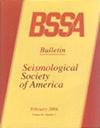Effects on Probabilistic Seismic Hazard Estimates That Result from Nonuniqueness in Declustering an Earthquake Catalog
IF 2.9
3区 地球科学
Q2 GEOCHEMISTRY & GEOPHYSICS
引用次数: 0
Abstract
Declustering a seismicity catalog to obtain a background seismicity model for probabilistic seismic hazard analysis is not a uniquely defined process. Zaliapin and Ben-Zion (2020) present a method for randomly thinning a complete catalog by removing nearest-neighbor earthquakes. The number of events in the residual catalog depends on a continuous parameter, α0, called the “cluster threshold.” Varying α0 results in a family of residual catalogs, and when enough events are removed the catalog is nearly Poissonian and can be considered declustered. This family of thinned catalogs is used to generate a corresponding family of background seismicity models, which in turn are used to find the probabilistic seismic hazard on an east–west profile across California. Additional models are developed by renormalizing the thinned Zaliapin and Ben-Zion (2020) catalogs to the catalog rate of earthquakes with moment magnitude Mw≥5 and from the maximum shaking earthquake catalog of Anderson et al. (2021). Adding fault contributions, the simplified estimate of the hazards with probability of exceedance of 2% in 50 yr are comparable to the 2018 National Seismic Hazard Model (NSHM). Where faults dominate the hazard, the method of thinning has little effect. The range of hazard estimates from the set of background models alone illustrate the range of effects of catalog thinning for any location where faults do not dominate. The spread of background hazard estimates at most sites is generally within a multiplicative factor of ∼2 of the hazard estimated from a catalog declustered for the 2018 NSHM. However, the spread in the estimates is very large in the vicinity of aftershock zones of large earthquakes. The family of randomly thinned catalogs, including alternative smoothing parameters and optional rescaling, may span the body and range of background hazard that can be inferred from the known history of earthquakes.地震分类中非唯一性对概率地震危险性估计的影响
对地震活动目录进行分类以获得用于概率地震危险性分析的背景地震活动模型并不是一个唯一定义的过程。Zaliapin和Ben-Zion(2020)提出了一种通过去除最近邻地震来随机细化完整目录的方法。剩余目录中事件的数量取决于一个连续的参数α0,称为“聚类阈值”。改变α0会产生一系列的剩余星表,当足够多的事件被移除时,这个星表几乎是泊松的,可以认为是散簇的。这组稀疏的目录被用来生成相应的背景地震活动模型,这些模型又被用来发现横跨加州东西剖面的概率地震危险。通过将Zaliapin和Ben-Zion(2020)的精简目录重新归一化为矩震级Mw≥5的地震目录率和Anderson等人(2021)的最大震动地震目录,开发了其他模型。加上断层的贡献,对50年内超过2%概率的灾害的简化估计与2018年国家地震灾害模型(NSHM)相当。在断层占主要危险的地方,减薄的方法效果不大。仅从一组背景模型得出的危险估计范围就说明了在任何不以断层为主的地点,目录变薄的影响范围。在大多数地点,背景危害估计的传播范围通常在2018年NSHM整理的目录中估计的危害的乘因子~ 2之内。然而,在大地震的余震区附近,估计的范围非常大。随机稀疏的目录族,包括可选的平滑参数和可选的重新标度,可以跨越可以从已知的地震历史推断出的背景灾害的范围和范围。
本文章由计算机程序翻译,如有差异,请以英文原文为准。
求助全文
约1分钟内获得全文
求助全文
来源期刊

Bulletin of the Seismological Society of America
地学-地球化学与地球物理
CiteScore
5.80
自引率
13.30%
发文量
140
审稿时长
3 months
期刊介绍:
The Bulletin of the Seismological Society of America, commonly referred to as BSSA, (ISSN 0037-1106) is the premier journal of advanced research in earthquake seismology and related disciplines. It first appeared in 1911 and became a bimonthly in 1963. Each issue is composed of scientific papers on the various aspects of seismology, including investigation of specific earthquakes, theoretical and observational studies of seismic waves, inverse methods for determining the structure of the Earth or the dynamics of the earthquake source, seismometry, earthquake hazard and risk estimation, seismotectonics, and earthquake engineering. Special issues focus on important earthquakes or rapidly changing topics in seismology. BSSA is published by the Seismological Society of America.
 求助内容:
求助内容: 应助结果提醒方式:
应助结果提醒方式:


